|
The USS Minneapolis (CA-36) was a New Orleans class heavy cruiser built for the United States Navy. She was the second ship named for Minneapolis, Minnesota. Her hull was laid down on 27 June 1931 at the Philadelphia Navy Yard. The new ship was 574 ft (175 m) long at the waterline (588 ft 2 in - 179.3 m overall) with a beam of 61 ft 9 in (18.8 m). She had a maximum draft of 23 ft 6 in (7.2 m). She displaced 9,950 tons. The ship had four props, each driven by a 26,750 shp (20,000 kW) Westinghouse geared turbine. Steam came from 8 x Babcock and Wilcox oil fuelled boilers. She carried 1,650 tons of fuel oil. The maximum speed was 32.7 knots (60.6 km/h).
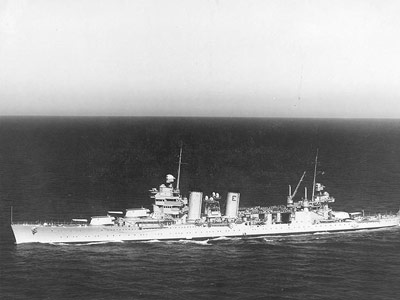 | 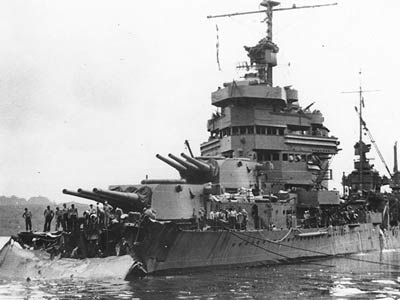 |
| The Minneapolis on 25 June 1938 | The bow of the Minneapolis after it was torpedoed |
The new ship had a crew of 708 officers and enlisted seamen. The ship had a massive array of firepower. There were nine 8 inch (200 mm)/55 cal guns (three barrels in each of three turrets, eight 5 inch (130 mm) 25 cal AA guns and eight 0.50 in (12.7 mm) machine guns. The Minneapolis also carried four floatplanes. These were launched from two catapults. The cruiser was heavily armoured, with 5 inch (130 mm) amidships, 1.5 inch (38 mm) fore and aft, 3 inch (76 mm) and 2 inch (51 mm) on the deck. The turrets had 5 to 6 inch (130 to 150 mm) on the face and 3 inch (76 mm) on the sides and back. The conning tower had a massive 8 inches (200 mm).
On 6 September 1933 the ship was launched by Miss Grace L. Newton and the USS Minneapolis was commissioned on 19 May 1934 as CA-36. The first commander was Captain Gordon W. Haines.
From July till September 1934 she did a shakedown cruise in European waters. She then returned to the US and had some alterations done in the Philadelphia Navy Yard. On 4 April 1935 she left for the San Diego, travelling via the Panama Canal. On 18 April 1935 she arrived and joined Cruiser Division 7 (CruDiv 7), Scouting Force. She primarily operated along the west coast, with one cruise to the Caribbean early in 1939. She arrived at Pearl Harbor in 1940.
When Japan attacked Pearl Harbor on 7 December 1941, USS Minneapolis was at sea for gunnery practice about 32 kilometres from Pearl Harbor. After the outbreak of war she took up patrol until late January 1942 when she joined a carrier task force about to raid the Gilbert and Marshall Islands.
 |
| The front of the Minneapolis after the bow was removed |
The Minneapolis took part in the Battle of the Coral Sea from 4 to 8 May 1942, screening the carrier USS Lexington through the great air engagement and shooting down three Japanese bombers. She rescued survivors when Lexington was lost. Her next major battle was the Battle of Midway. This was 3 to 6 June 1942.
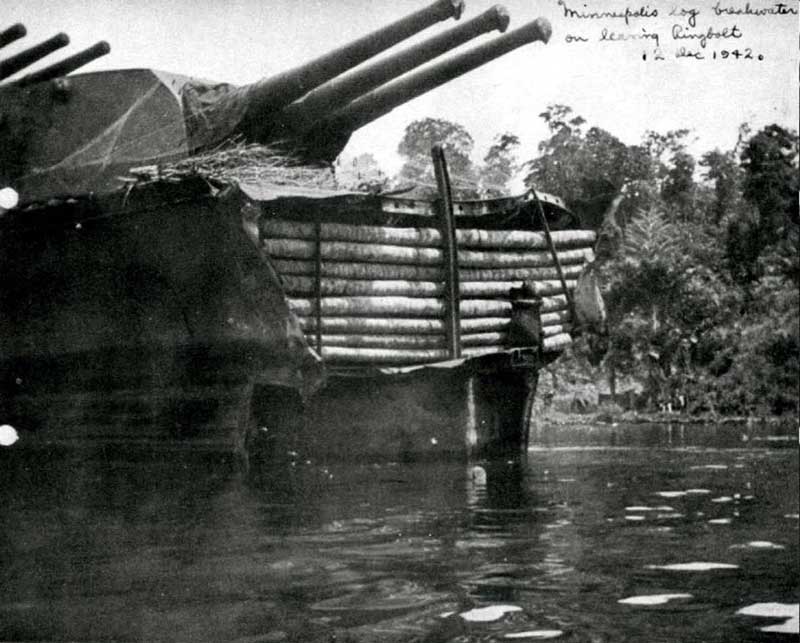 |
| The front of the Minneapolis showing the first temporary repair |
After Midway, she returned to Pearl Harbor for replenishing and repairing. This must have been pretty quick as she then sailed to the Solomon Islands for the invasion of Guadalcanal on 7 August 1942. When the famous aircraft carrier USS Saratoga (now a diveable wreck at Bikini Atoll) was a torpedoed on 30 August 1942, the Minneapolis towed her from the danger area. During September and October 1942 she supported landings west of Lunga Point and on Funafuti.
 ' ' |
| Plans showing all the damage to the Minneapolis - Click to see larger version | Link
On 29 November 1942 she was the flagship of Task Force 67 (TF 67) and she sortied to intercept a Japanese force attempting to reinforce Guadalcanal. At 23:05 the next night, she spotted six Japanese ships. The Battle of Tassafaronga was started when she fired her 8 inch guns. She scored many hits on IJNS Takanami, which sank. A second lot of Japanese warships, which was giving cover to the transport group, entered the action. The Minneapolis was hit by two torpedoes, one on the port bow and the other in her number two fireroom. This second torpedo caused a loss of power and severe damage as it opened up a huge hole. The bow was opened up back to the chain pipes, her port side badly ruptured, and, as mentioned, two fire rooms were open to the sea.
Frantic damage control work and skilful seamanship kept her afloat and enabled her to reach Tulagi. This is in the Florida Islands and is on the other side of Iron Bottom Canal from Guadalcanal. Before World War II this was the capital of the British Solomon Islands. During the war there was a lot of support infrastructure set up at Tulagi and nearby Ghavutu Island. The Minneapolis was taken to a small bay on the eastern side of the island. About two kilometres from the southern end. Here she was camouflaged with palm fronds and shrubs to protect her from the frequent air raids that the Japanese were carrying out.
 |
| A close up of the better temporary bow of the Minneapolis created in Espiritu Santo, New Hebrides |
In the bay, the damaged bow was cut off and left on the bottom. A new temporary bow was built by her own crew with the help of a Seabee unit stationed on the island (they may have actually been station on Ghavutu). This repair consisted of some welded sections below water and coocnut logs above water. After this work was carried out she sailed to Espiritu Santo in the New Hebrides (now Vanuatu) where a more substantial subby bow was welded in place.
After this, she steamed to the US. Some reports say that she had a new permanent bow installed at the Mare Island Naval Shipyard. This is off the city of Vallejo in California, about 37 kilometres northeast of San Francisco. Others (and photos) state that the repairs were done at Pearl Harbor and later, some major modifications were done at Mare Island.
If she was repaired at Pearl Harbor, then this seems to have been completed in April 1943. After the modifications at Mare Island (which seemed to take a while) she headed back to the Pacific in August 1943 for 20 months of front line duty which would include every major Pacific operation except Iwo Jima. The Minneapolis received 17 battle stars for World War II service. After the war, the ship was decommissioned on 10 February 1947 and placed in mothballs. She was struck off the Navy list on 1 March 1959 and scrapped on 14 August 1959
 |  |
The Minneapolis on the way back to be properly repaired at Pearl Harbor
Note the stumpy temporary bow | The bow of the Minneapolis after it was repaired |
Today, the bow of the USS Minneapolis still exists where it fell after being cut off the ship. It is about 1.27 kilometres north-west from the Tulagi Dive wharf to the small bay where the ship was repaired. This bay is home to a number of ship repair facilities and is also where a lot of fishing vessels moor. It also appears that some vessels use the bay as their departure point for trips to Honiara.
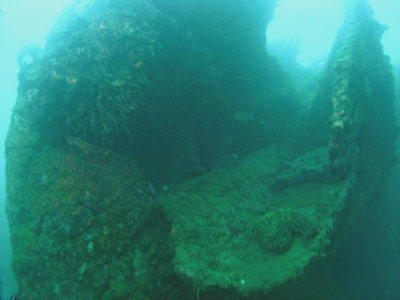 |  |
| The bow of the Minneapolis | The anchor hawser of the Minneapolis |
You could do this as a shore dive as it is so close to the shore. You head to GPS location S9° 54' 9.4" E159° 8' 40.1" (note that this is approximate - using WGS84 as a datum). You anchor just off the wharf area and the depth near the bow is about 20 metres and the top about 15 metres. A depth sounder will enable you to easily find the wreckage as it is quite large.
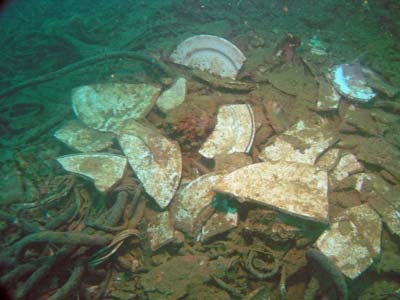 | 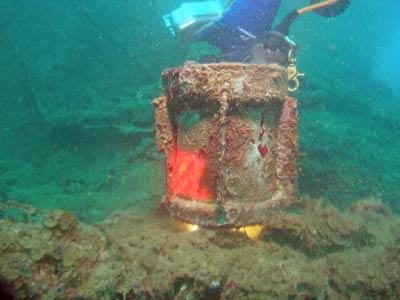 |
| China from the Minneapolis | A port light, possibly from the bow of the Minneapolis |
As you gear up, all the crew and passengers on the ferries and trawlers will be watching you with a lot of interest. Once you descend you should be near the bow. The bottom is a bit silty so it is important to stay off the bottom. The bow itself is very obvious. It is upsidedown and facing out from the shore, down towards the deep. It faces north or north-east. About 30 metres north-east of the bow in about 20 to 22 metres there are about 50 to 100 live eight inch naval shells (thanks to Rob Pinkerton for this information).
The bow is very wrecked. The damage caused by the torpedo is stunning. It appears that the torpedo hit on the port side. Just back from the bow itself you can see the huge anchor hawser (interestingly, when a new bow was built for the ship back in the US, there was no hawser on the port side).
Back near where the bow broke off the ship, the wreck stands high. Here you can see into a small section of the wreck. Near here there are China plates from the ship as well as port and starboard lights. I am not sure if these are from the Minneapolis. There is also a toilet here, it is possible it is from the ship as normally the bow was a place where there were lots of bathrooms.
 |  |
| This lifeboat appears to be made of metal | The landing craft, the bow/door is at bottom |
There is a lot of other stuff to see on this dive. The bottom slopes down from the shallows near the shore and you can see the boats moored and anchored nearby. To the south-east of the bow there is a huge steel buoy. To the south there is what appears to be a World War II landing craft. This sits facing down to the deeper water. The door is open and up shallower you can see the engine area. Above here you will probably see one or more trawlers/passenger ferries tied up at the wharf.
To the north-west there are huge tyres and hundreds of 44 gallon drums under the boats moored there. You can swim right up under the boats without danger. Closer to the bow and west of it there are some complete boats on the bottom. One appears to be a lifeboat and the other I am not sure. The lifeboat seems to be made of metal. There are also lots of batteries all over the place.
 | 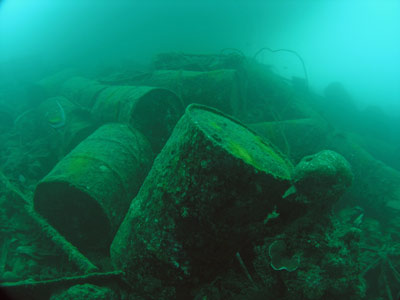 |
This toilet may be from the Minneapolis
as the wreck is in the background | These 44 gallon drums are under some
of the ferries, the shadow at top |
This is an interesting fossicking dive, with lots of junk to be seen. There is also some interesting fishlife. The maximum depth can be basically whatever you want as the bottom slopes away from here. I did about 22 metres and saw everything that I wanted to. We did about 60 minutes.
Visibility was about 10 metres with a water temperature of more than 28°C. A nice easy second shallow dive after a very deep first dive.
| 
 v6.00.307 © 2003-2005
v6.00.307 © 2003-2005